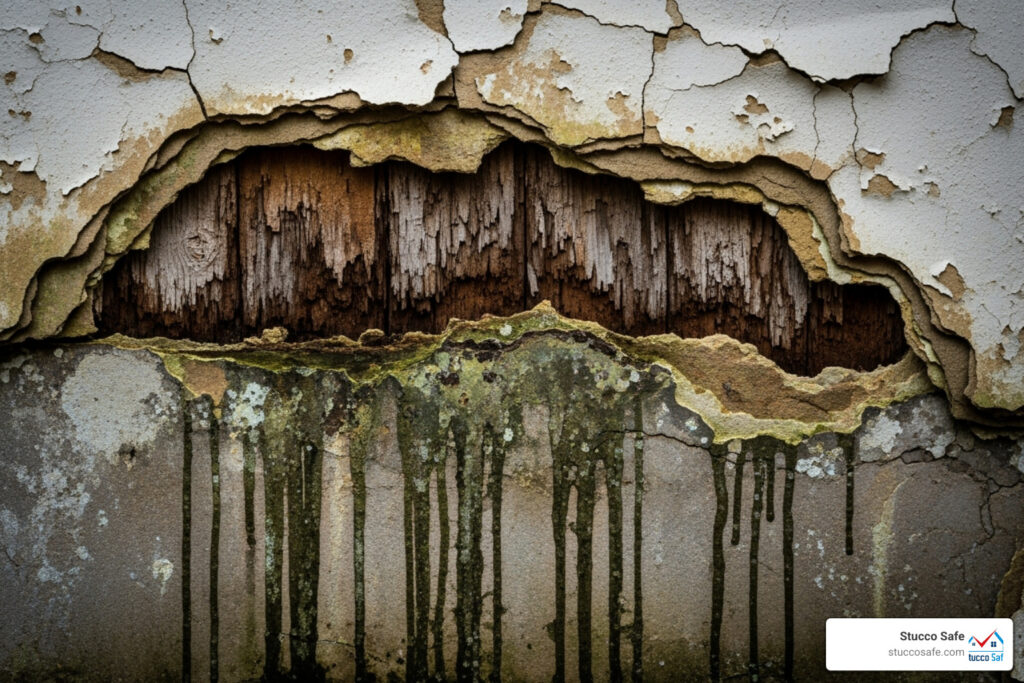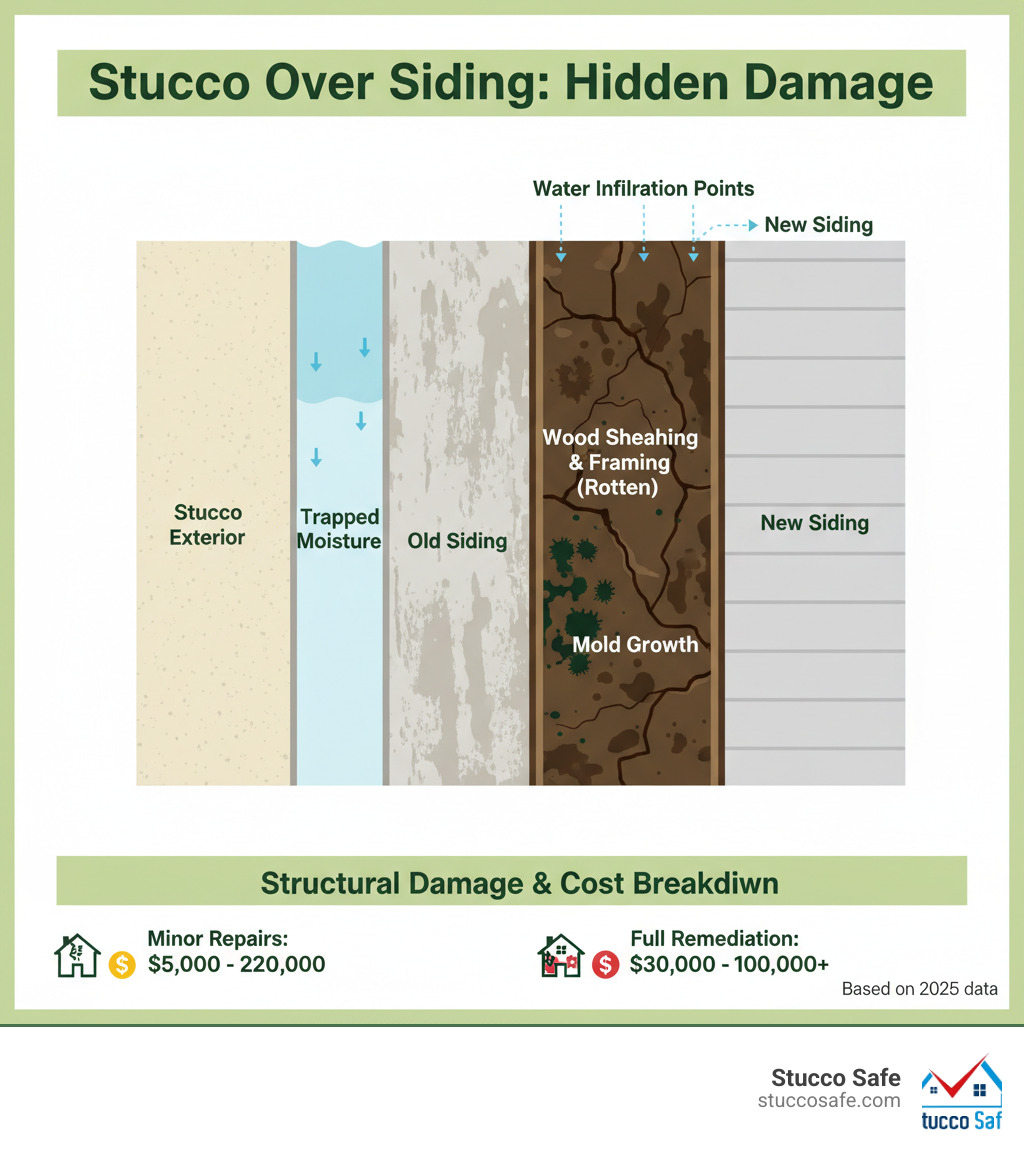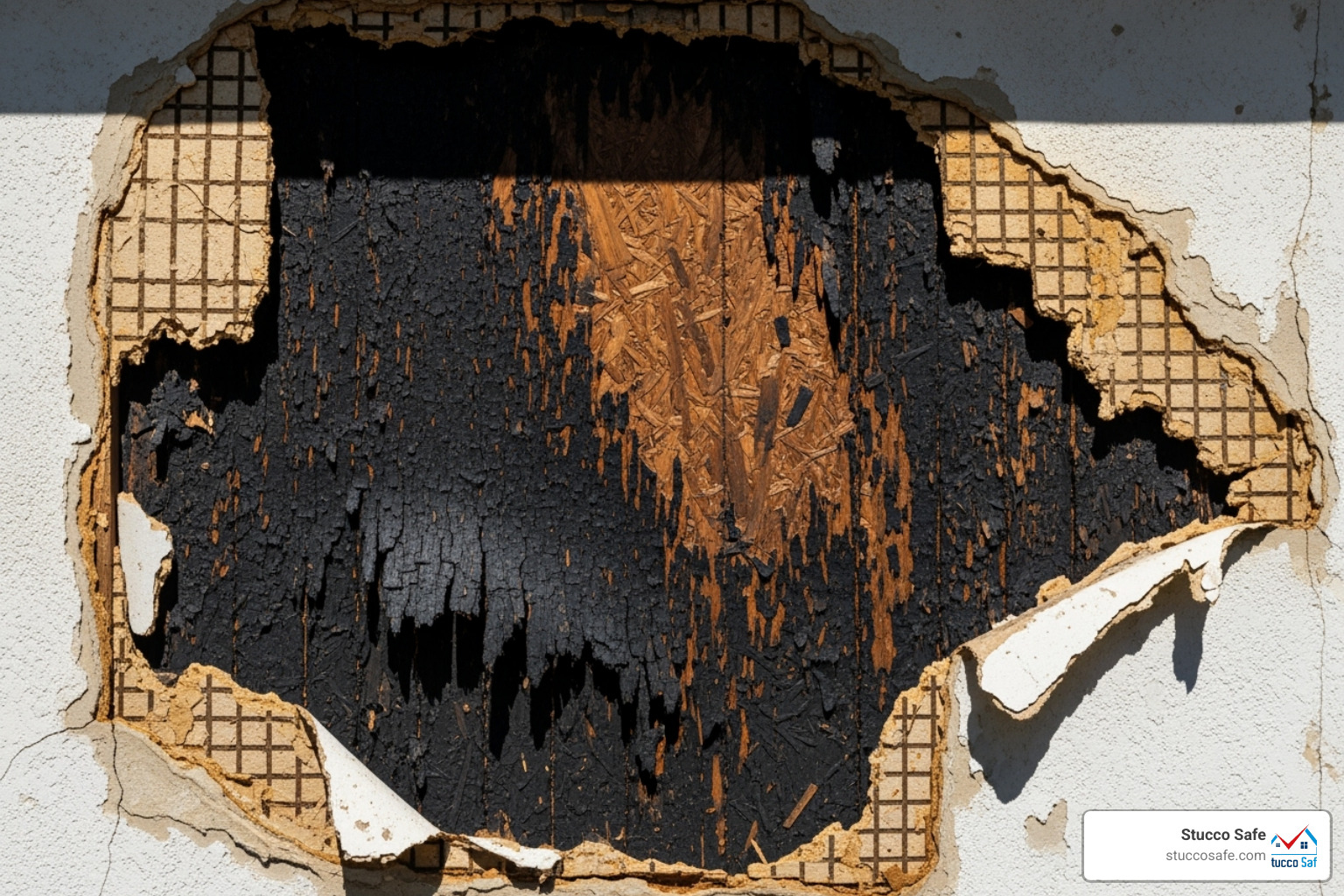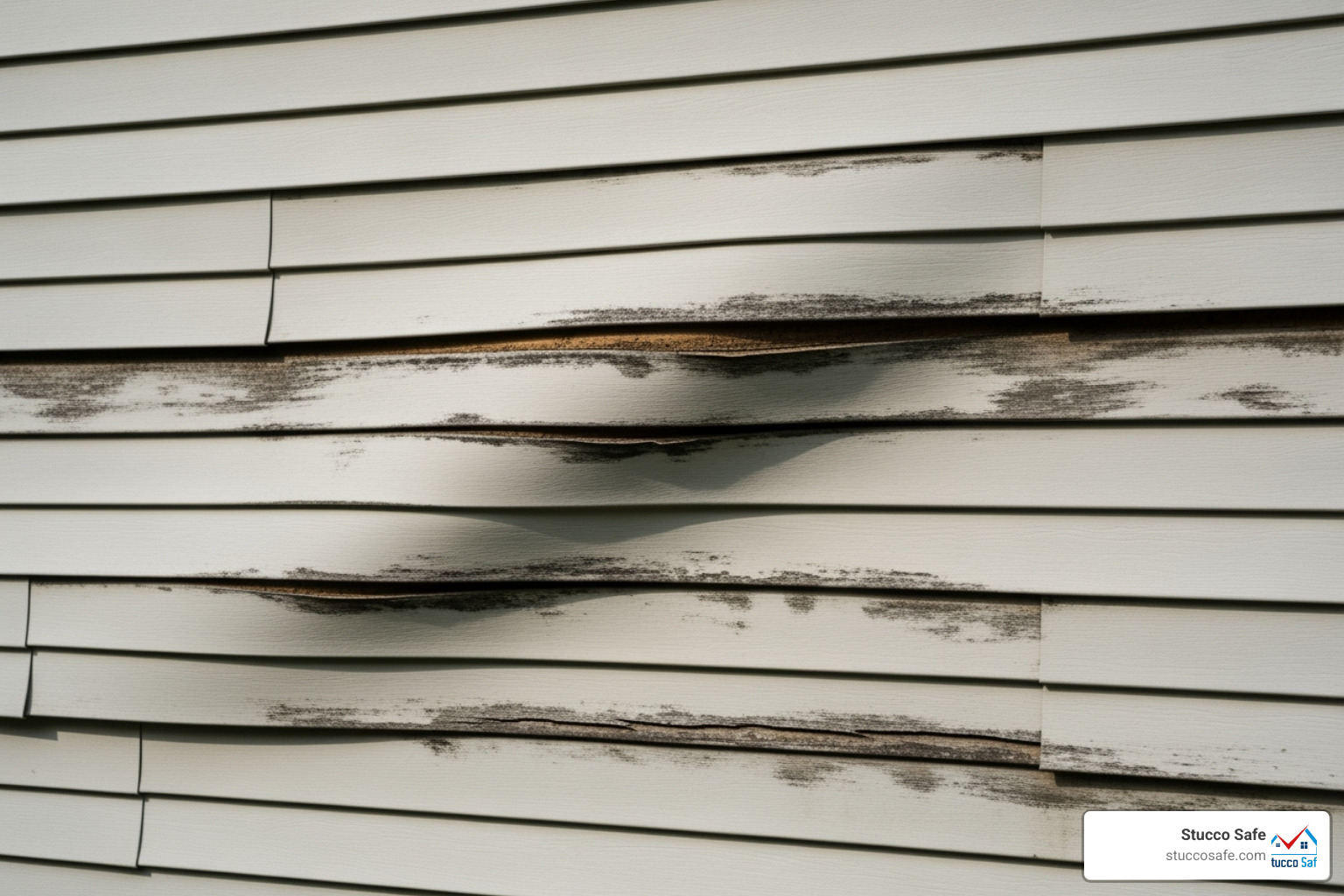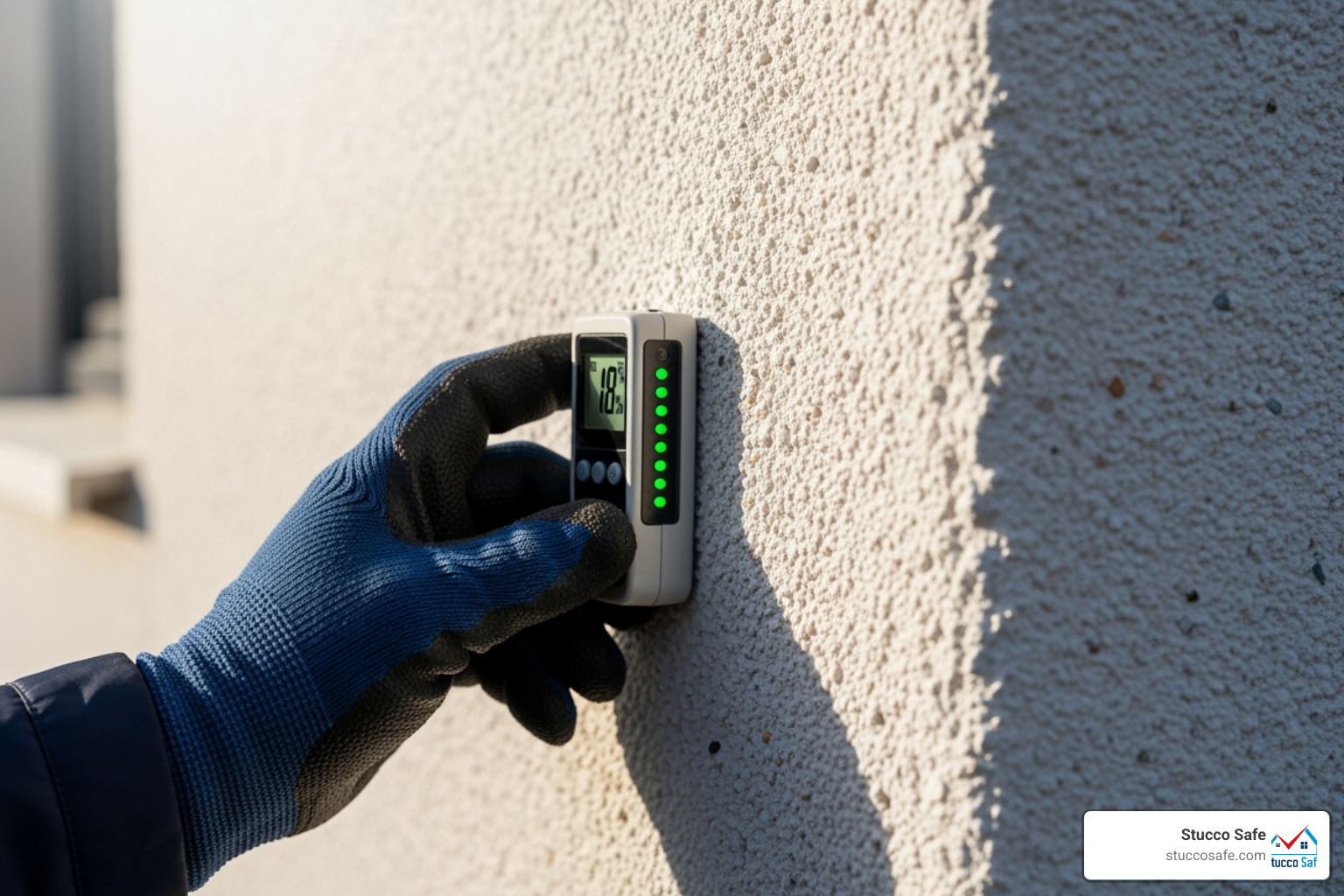Stucco over siding problems: The #1 Danger
Why Stucco Over Siding Creates Hidden Nightmares
Stucco over siding problems are a hidden threat, often causing tens of thousands of dollars in damage that can go unnoticed for years. While covering old stucco with new siding seems like a smart cosmetic update, it frequently creates a “moisture sandwich,” trapping water against your home’s structure.
This trapped moisture leads to severe issues, including:
- Rotted wood sheathing and framing
- Widespread mold growth in wall cavities
- Structural damage costing $30,000-$100,000+ to remediate
- Termite infestations drawn to damp wood
Research indicates that over 90% of stucco in the Northeastern U.S. from the last two decades was improperly installed. Placing siding over this faulty stucco without remediation creates a ticking time bomb. One Franklin Township, NJ homeowner’s cosmetic update turned into a $38,000 remediation project due to hidden water damage.
The greatest danger is that this damage remains invisible until it becomes catastrophic and expensive to fix.
I’m Gabe Kesslick, founder of Stucco Safe. Since 2015, my team and I have specialized in building envelope forensics, with certifications from EDI, BESI, and AWCI. Through hundreds of inspections across Southeastern Pennsylvania, New Jersey, and Delaware, I’ve seen how this seemingly simple project can lead to structural disaster.
Why Siding Over Stucco Seems Like a Good Idea (And Why It’s Not)
Homeowners are often tempted to install siding over existing stucco. It seems like a logical way to boost curb appeal, cover cracked or stained stucco, and get a low-maintenance exterior without the perceived cost and hassle of stucco repairs. The desire for aesthetic modernization is a powerful motivator.
Unfortunately, this seemingly straightforward project has a fundamental flaw rooted in building science that can turn a dream update into a costly nightmare.
The Critical Flaw: Turning Your Walls Into a Moisture Sandwich
The problem begins with a common misconception: stucco isn’t waterproof. It’s a porous material designed to absorb some moisture and then dry out. This process requires proper flashing, drainage, and airflow to function correctly.
When you install siding directly over stucco, you create a double barrier that traps moisture. The new siding prevents the stucco from drying to the outside, while the stucco continues to absorb water from any small leak. This trapped water has nowhere to go.
This “moisture sandwich” is one of the most destructive things you can do to your home. The lack of airflow means even small amounts of moisture will sit for weeks or months, causing accelerated rot in your wood sheathing and framing. This can also lead to widespread mold growth and compromise your home’s structural integrity. The sheathing damage alone can cost tens of thousands to repair.
What appears to be a simple, cost-effective fix can create hidden damage far more expensive than the original stucco problems ever were. To learn more about how stucco interacts with water, see our guides on What Are the Problems with Stucco Houses?, Does Stucco Absorb Water?, and Moisture Intrusion Stucco issues.
The Core of Stucco Over Siding Problems: Moisture Intrusion and Hidden Damage
When we remove siding that was placed over stucco, the damage is often shocking. The image below shows rotted, black OSB sheathing—a clear sign of structural decay that threatens the entire home.
The core issue with stucco over siding problems is that water gets in but can’t get out. Water enters through tiny openings like improper flashing around windows, failed caulking, and missing kick-out flashing where a roof meets a wall. These small gaps can channel thousands of gallons of water into your walls over time. Other common entry points include weep screed blockage at the base of the wall and stucco installed below grade, which wicks moisture up from the ground. For more details, see our guide on Moisture Intrusion Stucco.
How Trapped Moisture Wreaks Havoc
Once inside, the water is trapped between the siding and the stucco. With no way to dry, the destruction begins. We’ve found bottom plates so rotted you could push a screwdriver through them with your thumb. This relentless moisture saturation leads to:
- Rotting Wood Framing: The structural members of your home begin to decay.
- Mold Growth: Mold can start within 48 hours, degrading materials and posing serious health risks.
- Termite Infestations: As noted in a PCO article on Stucco Remediation, Mold and Termites, termites are drawn to moisture-damaged wood, causing further hidden damage.
Long-Term Consequences
The scariest part is how these problems hide in plain sight. A slight bulge in your siding, as seen below, is a symptom of advanced structural rot.
This delamination and bubbling occurs as trapped moisture causes the stucco to detach from the substrate. Learn more in our guide on Bubbling Stucco: A Guide to Prevention and Repair.
The financial impact is staggering. Remediation costs range from $10,000 to over $100,000. Property values plummet, and health risks from hidden mold can affect your family’s well-being. Our invasive moisture tests frequently find readings above 30% (anything over 19% is a concern), representing extensive, silent damage.
Before You Cover It Up: Assessing Your Stucco and Preparing for Siding
Covering up existing stucco problems is like putting a band-aid on a broken bone—it hides the issue while it gets worse. A professional stucco inspection, costing between $495 to $1595, is a small price to pay to avoid potential remediation costs of $30,000 to $100,000. An unbiased inspection is critical; learn more here: Why Hire a Separate Stucco Inspector?.
Identifying Potential Problems Before You Begin
Look for these warning signs that indicate underlying issues:
- Cracks: Hairline cracks are normal, but anything wider than a credit card (1/16 inch) is a red flag for water intrusion.
- Bulging or Soft Spots: Spongy areas indicate the stucco has detached from the wall, usually due to moisture.
- Stains and “Stucco Tears”: Dark streaks below windows or rooflines are evidence of water running into the wall system.
- Efflorescence: White, chalky deposits are left behind as water evaporates from the stucco surface.
- Hollow Sounds: Tapping on the wall may reveal hollow sounds, indicating the stucco has delaminated.
Our forensic moisture testing regularly finds moisture readings above 30% in areas that look fine externally. Any reading over 19% is a serious concern. See more about our methods at Stucco Inspection and Testing.
Traditional Stucco vs. EIFS: A Critical Distinction
It’s vital to know what type of stucco you have.
- Traditional Hard-Coat Stucco: A cement-based, porous material designed to breathe—it absorbs some moisture and dries out. It feels hard and solid when tapped.
- EIFS (Synthetic Stucco): A multi-layer system with a foam insulation board. Older EIFS were “barrier systems” that trap any water that gets behind them, leading to widespread rot and mold. EIFS often sounds hollow when tapped.
The risks of stucco over siding problems are much higher with EIFS. For more on this, visit our EIFS Moisture Problems page and this external guide on common EIFS issues.
When Full Stucco Removal is Non-Negotiable
Sometimes, covering stucco is not an option. Full removal is necessary if an inspection reveals:
- Extensive Water Damage: Moisture readings consistently above 19% indicate the underlying structure is compromised.
- Structural Rot: If the wood framing is decayed, it must be replaced.
- Widespread EIFS Failure: Given the risks, failing EIFS systems should be removed, not covered.
- Crumbling or Delaminating Stucco: You cannot attach new siding to a failing substrate. See this discussion for homeowner experiences: stucco problem crumbling off home…..Need advice.
- High Repair Costs: If the cost to repair the stucco approaches the cost of replacement, starting fresh is the smarter financial choice.
The Right Way to Install Siding Over Stucco
There’s a right way and a wrong way to install siding over stucco. The wrong way—nailing siding directly to the stucco—is a recipe for the stucco over siding problems we’ve discussed. The right way involves a rainscreen system that protects your home. The difference is stark:
| Feature | Wrong Way (Siding Directly on Stucco) | The Right Way (Using a Rainscreen System) |
|---|---|---|
| Preparation | No inspection, no repairs, no moisture management. | Thorough inspection, repair of all existing stucco damage, ensure flat surface. |
| Moisture Barrier | Relies on existing stucco as a barrier (which is porous). | Install a new, continuous water-resistive barrier (WRB) over the repaired stucco. |
| Drainage Plane | None, traps moisture between siding and stucco. | Install vertical furring strips over the WRB, creating a crucial air/drainage gap (rainscreen). This allows water to drain and air to circulate for drying. |
| Flashing & Sealing | Often inadequate or nonexistent. | Install proper flashing at all penetrations (windows, doors, vents) and junctions, including kick-out flashing. Ensure all new components are carefully sealed. |
| Siding Installation | Nailed directly into stucco, potentially compromising integrity. | Siding is installed onto the furring strips, ensuring it’s securely fastened and maintains the drainage gap. |
| Long-Term Outcome | High risk of hidden moisture damage, rot, mold, structural failure, costly remediation. | Significantly reduced risk of moisture problems, improved durability, improved energy efficiency, easier to inspect and maintain, peace of mind. |
The Proper Installation Process
If a professional inspection confirms it’s safe, the proper installation process is as follows:
- Stucco Repair: All cracks and damaged areas must be repaired to create a stable, flat surface.
- Install Water-Resistive Barrier (WRB): A high-quality house wrap is installed over the repaired stucco, with all seams sealed.
- Install Furring Strips: Vertical strips are attached through the WRB into the home’s framing. This creates a rainscreen—a crucial air gap for drainage and drying.
- Install Siding: The new siding is attached to the furring strips, not the stucco, maintaining the drainage gap.
- Flash and Seal: All windows, doors, and penetrations must be properly flashed and sealed to integrate with the new system.
Best Siding Materials and Energy Efficiency
Good material choices for a rainscreen system include:
- Vinyl Siding: Cost-effective, low-maintenance, and lightweight.
- Fiber Cement Siding: Extremely durable, resistant to rot, pests, and fire.
- Metal Siding: Offers a modern look with exceptional durability and minimal maintenance.
- Wood Siding: Provides a classic, natural look but requires regular maintenance.
A properly installed system also improves energy efficiency. The new siding adds insulation, and the air gap acts as a thermal break, reducing heat transfer. This can lead to significant energy savings and a more comfortable home.
Frequently Asked Questions about Stucco Over Siding
Homeowners often have questions about costs, insurance, and DIY options. Getting clear answers is key to avoiding costly mistakes.
Will homeowners insurance cover damage from improperly installed siding over stucco?
Unfortunately, the answer is almost always no. Stucco damage claims are among the most denied homeowners insurance claims. Most policies exclude gradual damage, faulty workmanship, and construction defects—the exact causes of stucco over siding problems. Insurers see this as a maintenance issue, not a sudden, accidental event like a fire or storm damage. While keeping detailed documentation of all inspections and work is wise, you should not expect your policy to cover long-term moisture damage from an improper installation.
What are the cost implications of siding over stucco?
The financial breakdown can be surprising:
- Initial Installation: Expect to pay $25,000 to $75,000 for a professional installation with a proper rainscreen system, depending on home size and materials.
- Stucco Inspection: A pre-installation inspection costs between $495 and $1595. This is a critical investment.
- Potential Remediation: If you skip the inspection and cover existing problems, remediation costs can range from $10,000 to over $100,000. The small cost of an inspection is your best defense against these massive, unexpected expenses.
While covering stucco may seem cheaper upfront, the financial risk of hidden damage makes it a dangerous gamble.
Can I DIY a siding-over-stucco project?
While the savings are tempting, installing siding over stucco is not a recommended DIY project. The risks are simply too high. This job requires specialized knowledge of building science, moisture management, and proper flashing techniques. A small mistake can lead to catastrophic and expensive damage.
Furthermore, improper installation can void material warranties and cause structural issues that threaten your home’s value and safety. The potential for causing tens of thousands of dollars in hidden damage far outweighs any savings. Hiring an experienced, insured professional is the only financially sound choice for a project this complex.
Conclusion
When considering a new exterior, the shortcut of placing siding over stucco can become a homeowner’s most expensive mistake. The core issue is creating a “moisture sandwich” that traps water, leading to silent, hidden destruction. This trapped moisture causes rot, mold, and structural damage that can cost anywhere from $30,000 to $100,000 or more to remediate.
Covering up a problem is never the solution. The cracks and stains on your stucco are warnings of deeper issues that must be addressed, not hidden. A pre-installation inspection is non-negotiable. For a small investment of $495 to $1595, our forensic testing can uncover hidden moisture and structural problems, protecting you from massive repair bills down the road.
For homeowners in Southeastern Pennsylvania, New Jersey, and Delaware, a professional evaluation is the only way to ensure your home’s safety and protect your investment. While installing siding over stucco can be done correctly with a proper rainscreen system, it requires expertise.
Don’t gamble with your home’s structural integrity. Protect your investment by understanding the true condition of your home’s exterior. Contact Stucco Safe today for a professional inspection to get the facts you need to make a safe, informed decision.

